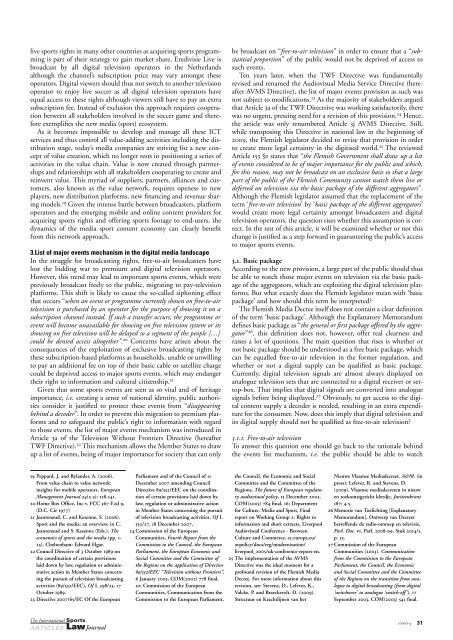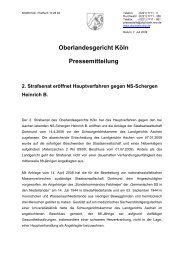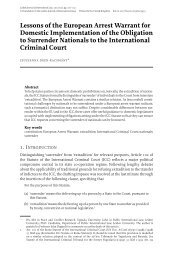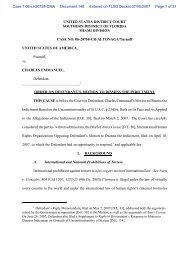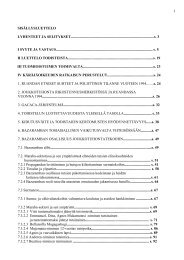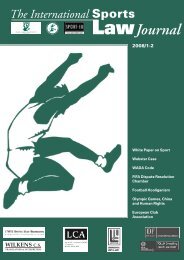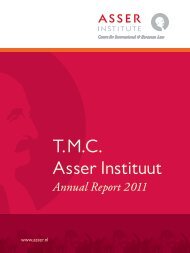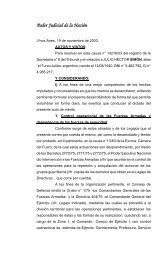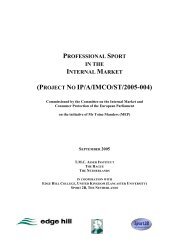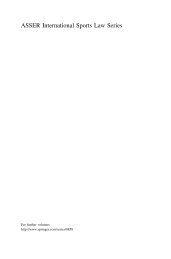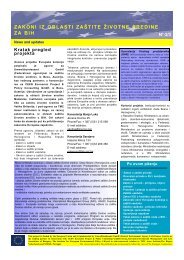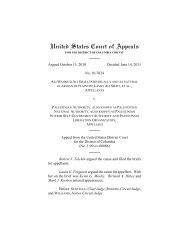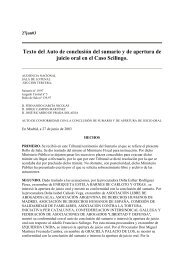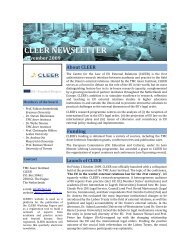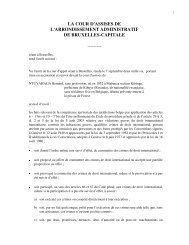Islj 2009 3-4 - TMC Asser Instituut
Islj 2009 3-4 - TMC Asser Instituut
Islj 2009 3-4 - TMC Asser Instituut
Create successful ePaper yourself
Turn your PDF publications into a flip-book with our unique Google optimized e-Paper software.
live sports rights in many other countries as acquiring sports programming<br />
is part of their strategy to gain market share, Eredivisie Live is<br />
broadcast by all digital television operators in the Netherlands<br />
although the channel’s subscription price may vary amongst these<br />
operators. Digital viewers should thus not switch to another television<br />
operator to enjoy live soccer as all digital television operators have<br />
equal access to these rights although viewers still have to pay an extra<br />
subscription fee. Instead of exclusion this approach requires cooperation<br />
between all stakeholders involved in the soccer game and therefore<br />
exemplifies the new media (sport) ecosystem.<br />
As it becomes impossible to develop and manage all these ICT<br />
services and thus control all value-adding activities including the distribution<br />
stage, today’s media companies are striving for a new concept<br />
of value creation, which no longer rests in positioning a series of<br />
activities in the value chain. Value is now created through partnerships<br />
and relationships with all stakeholders cooperating to create and<br />
reinvent value. This myriad of suppliers, partners, alliances and customers,<br />
also known as the value network, requires openess to new<br />
players, new distribution platforms, new financing and revenue sharing<br />
models. 19 Given the intense battle between broadcasters, platform<br />
operators and the emerging mobile and online content providers for<br />
acquiring sports rights and offering sports footage to end-users, the<br />
dynamics of the media sport content economy can clearly benefit<br />
from this network approach.<br />
3.List of major events mechanism in the digital media landscape<br />
In the struggle for broadcasting rights, free-to-air broadcasters have<br />
lost the bidding war to premium and digital television operators.<br />
However, this trend may lead to important sports events, which were<br />
previously broadcast freely to the public, migrating to pay-television<br />
platforms. This shift is likely to cause the so-called siphoning effect<br />
that occurs “when an event or programme currently shown on free-to-air<br />
television is purchased by an operator for the purpose of showing it on a<br />
subscription channel instead. If such a transfer occurs, the programme or<br />
event will become unavailable for showing on free television system or its<br />
showing on free television will be delayed so a segment of the people […]<br />
could be denied access altogether”. 20 Concerns have arisen about the<br />
consequences of the exploitation of exclusive broadcasting rights by<br />
these subscription-based platforms as households, unable or unwilling<br />
to pay an additional fee on top of their basic cable or satellite charge<br />
could be deprived access to major sports events, which may endanger<br />
their right to information and cultural citizenship. 21<br />
Given that some sports events are seen as so vital and of heritage<br />
importance, i.e. creating a sense of national identity, public authorities<br />
consider it justified to protect these events from “disappearing<br />
behind a decoder”. In order to prevent this migration to premium platforms<br />
and to safeguard the public’s right to information with regard<br />
to those events, the list of major events mechanism was introduced in<br />
Article 3a of the Television Without Frontiers Directive (hereafter<br />
TWF Directive). 22 This mechanism allows the Member States to draw<br />
up a list of events, being of major importance for society that can only<br />
be broadcast on “free-to-air television” in order to ensure that a “substantial<br />
proportion” of the public would not be deprived of access to<br />
such events.<br />
Ten years later, when the TWF Directive was fundamentally<br />
revised and renamed the Audiovisual Media Service Directive (hereafter<br />
AVMS Directive), the list of major events provision as such was<br />
not subject to modifications. 23 As the majority of stakeholders argued<br />
that Article 3a of the TWF Directrive was working satisfactorily, there<br />
was no urgent, pressing need for a revision of this provision. 24 Hence,<br />
the article was only renumbered Article 3j AVMS Directive. Still,<br />
while transposing this Directive in national law in the beginning of<br />
<strong>2009</strong>, the Flemish legislator decided to revise that provision in order<br />
to create more legal certainty in the digitised world. 25 The reviewed<br />
Article 153 §1 states that “the Flemish Government shall draw up a list<br />
of events considered to be of major importance for the public and which,<br />
for this reason, may not be broadcast on an exclusive basis so that a large<br />
part of the public of the Flemish Community cannot watch them live or<br />
deferred on television via the basic package of the different aggregators”.<br />
Although the Flemish legislator assumed that the replacement of the<br />
term ‘free-to-air television’ by ‘basic package of the different aggregators’<br />
would create more legal certainty amongst broadcasters and digital<br />
television operators, the question rises whether this assumption is correct.<br />
In the rest of this article, it will be examined whether or not this<br />
change is justified as a step forward in guaranteeing the public’s access<br />
to major sports events.<br />
3.1. Basic package<br />
According to the new provision, a large part of the public should thus<br />
be able to watch those major events on television via the basic package<br />
of the aggregators, which are exploiting the digital television platforms.<br />
But what exactly does the Flemish legislator mean with ‘basic<br />
package’ and how should this term be interpreted?<br />
The Flemish Media Decree itself does not contain a clear definition<br />
of the term ‘basic package’. Although the Explanatory Memorandum<br />
defines basic package as “the general or first package offered by the aggregator”<br />
26 , this definition does not, however, offer real clearness and<br />
raises a lot of questions. The main question that rises is whether or<br />
not basic package should be understood as a free basic package, which<br />
can be equalled free-to-air television in the former regulation, and<br />
whether or not a digital supply can be qualified as basic package.<br />
Currently, digital television signals are almost always displayed on<br />
analogue television sets that are connected to a digital receiver or settop-box.<br />
That implies that digital signals are converted into analogue<br />
signals before being displayed. 27 Obviously, to get access to the digital<br />
content supply a decoder is needed, resulting in an extra expenditure<br />
for the consumer. Now, does this imply that digital television and<br />
its digital supply should not be qualified as free-to-air television?<br />
3.1.1. Free-to-air television<br />
To answer this question one should go back to the rationale behind<br />
the events list mechanism, i.e. the public should be able to watch<br />
19 Peppard, J. and Rylander, A. (2006).<br />
From value chain to value network:<br />
insights for mobile operators, European<br />
Management Journal 24(2-3): 128-141.<br />
20 Home Box Office, Inc v. FCC 567 F.2d 9,<br />
(D.C. Cir 1977)<br />
21 Jeanrenaud, C. and Kesenne, S. (2006).<br />
Sport and the media: an overview, in C.<br />
Jeanrenaud and S. Kesenne (Eds.), The<br />
economics of sports and the media (pp. 1-<br />
25). Cheltenham: Edward Elgar.<br />
22 Council Directive of 3 October 1989 on<br />
the coordination of certain provisions<br />
laid down by law, regulation or administrative<br />
action in Member States concerning<br />
the pursuit of television broadcasting<br />
activities (89/552/EEC), OJ L 298/23, 17<br />
October 1989.<br />
23 Directive 2007/65/EC Of the European<br />
Parliament and of the Council of 11<br />
December 2007 amending Council<br />
Directive 89/552/EEC on the coordination<br />
of certain provisions laid down by<br />
law, regulation or administrative action<br />
in Member States concerning the pursuit<br />
of television broadcasting activities, OJ L<br />
332/27, 18 December 2007.<br />
24 Commission of the European<br />
Communities, Fourth Report from the<br />
Commission to the Council, the European<br />
Parliament, the European Economic and<br />
Social Committee and the Committee of<br />
the Regions on the application of Directive<br />
89/552/EEC “Television without Frontiers”,<br />
6 January 2003, COM(2002) 778 final,<br />
10; Commission of the European<br />
Communities, Communication from the<br />
Commission to the European Parliament,<br />
the Council, the Economic and Social<br />
Committee and the Committee of the<br />
Regions, The future of European regulatory<br />
audiovisual policy, 15 December 2003,<br />
COM(2003) 784 final, 16; Department<br />
for Culture, Media and Sport, Final<br />
report on Working Group 2: Rights to<br />
information and short extracts, Liverpool<br />
Audiovisual Conference - Between<br />
Culture and Commerce, ec.europa.eu/<br />
avpolicy/docs/reg/modernisation/<br />
liverpool_2005/uk-conference-report-en.<br />
25 The implementation of the AVMS<br />
Directive was the ideal moment for a<br />
profound revision of the Flemish Media<br />
Decree. For more information about this<br />
revision, see: Stevens, D., Lefever, K.,<br />
Valcke, P. and Braeckevelt, D. (<strong>2009</strong>).<br />
Structuur en Krachtlijnen van het<br />
Nieuwe Vlaamse Mediadecreet. A&M. (in<br />
press); Lefever, K. and Stevens, D.<br />
(<strong>2009</strong>). Vlaamse mediadecreten in nieuw<br />
en toekomstgericht kleedje, Juristenkrant<br />
187: 4-5.<br />
26 Memorie van Toelichting [Explanatory<br />
Memorandum], Ontwerp van Decreet<br />
betreffende de radio-omroep en televisie,<br />
Parl. Doc. VI. Parl. 2008-09, Stuk 2014/1,<br />
p. 53.<br />
27 Commission of the European<br />
Communities (2003). Communication<br />
from the Commission to the European<br />
Parliament, the Council, the Economic<br />
and Social Committee and the Committee<br />
of the Regions on the transition from analogue<br />
to digital broadcasting (from digital<br />
‘switchover’ to analogue ‘switch-off’), 17<br />
September 2003, COM(2003) 541 final.<br />
A RT I C L E S<br />
<strong>2009</strong>/3-4 31


